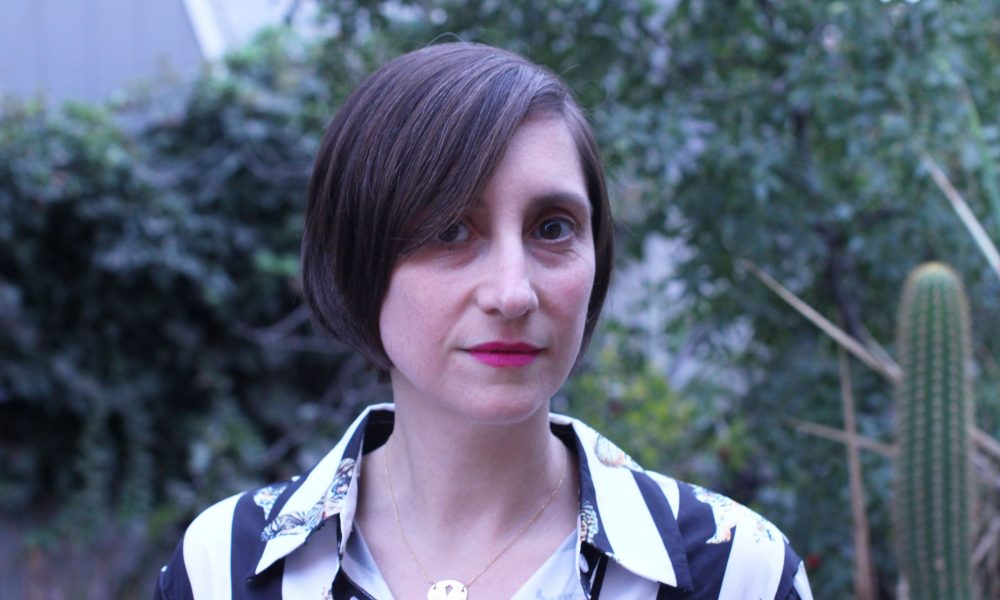

Today we’d like to introduce you to Rotem Rozental.
Hi Rotem, please kick things off for us with an introduction to yourself and your story.
No matter what turn life took, it always led me to artists, their histories, practice, and the exciting futures their works could have. My mother used to take me to local museums in Tel Aviv frequently when I was a child. I have vivid memories of class tours and film days. I was so moved when I got to share Paul Signac’ Mirabeuu Bridge (https://artsandculture.google.com/asset/mirabeau-bridge-paul-signac/EQHcMu5vDo0alQ?hl=en) with my son during a pre-Corona visit to Israel, at the same museum where I first saw and learned about it when I was in elementary school. I was barely 20 when I was hired as a gallery assistant in Tel Aviv. It was a life-defining experience. I met the most thought-provoking artists and got to see their work develop up-close. It made me realize I have to know what came before them in order to better understand how do they fit into this exciting fabric of local and international creativity. That is how I found myself studying art history and philosophy and working as an art and lifestyle reporter in local magazines and newspapers. It was an electrifying moment of transition in the local scene, and suddenly digital art took center stage in a new and commanding way. In response, I organized independent video art events in clubs with a collaborator and my dear friend, Gaby Ron. We used to take over parties and events with an immersive video art screenings and installations. From that moment on, I never stopped organizing, producing, mentoring, writing, curating, studying and teaching art through exhibitions, events, creative projects, classes and publications. I was fortunate enough to collaborate with international artists and organizations while still in Israel as online editorial director, curator, scholar and consultant.
I never wondered if I should have pursued another field. I never questioned the choice to carve my own niche in curation, content and scholarship. If I had a dollar for every time I was asked, “okay, but what will you *do* with a BA in art history and philosophy?” I probably would have been able to fund for three more degrees. I never had a doubt because it was obvious to me I will find a way to make it work, to define some uncharted waters. Our generation had to re-invent any occupation we had since the rules kept changing and no one prepared us for that whatsoever. Technology shifted everything we knew so quickly, and we had to adapt, for better or worse. I remember the feeling that I am the last person standing, waiting to turn off the lights, in every newspaper I worked for, but it also felt incredible to pivot and find new ways to offer content and support creatives on their journeys.
Not to say that I don’t have self-doubts, but the ability to shift just might be the most important skill we need to nurture. Not everybody around me understood how I could move to the US a decade ago for Ph.D studies while already having a successful career. But I would have never forgiven myself for not taking that leap. Luckily, my husband is an incredible partner that understood that leap is crucial. That move was so complicated and exhausting mentally and physically, but it has been such an amazing adventure. I get to wake up every morning and work with and for artists, students, life-long learners and community members.
Would you say it’s been a smooth road, and if not what are some of the biggest challenges you’ve faced along the way?
I was once in a room full of artists during a workshop with a more established writer. He spoke about how kids are a distraction from the work. I was already a mother, my son was then nearly three years old. My blood was boiling. I remember a veteran professor explaining to one of my peers how female graduate students disappear when they have kids. “I don’t care,” she told him, “I know what is important,” I admired her for that. My children are not a logistical interruption, they are the source of my creativity and my view of the world. My children attended artist retreats, conferences, openings, talks and live shows before they could talk. They got to see their mother defends her Dissertation and open exhibitions with artists from all over the world. In pre-Covid times, we traveled extensively for our projects across the world. Not only that it works, I have no doubt it made me a better curator, writer and scholar. The art world still insists to idealize the image of the lone artist, embedded in their craft, devoted to their work and nothing else. But that is not how it works. We have relationships, lives, emotions, thoughts, needs, and our families fuel our work. I would love to see more residencies for artists with families, for instance. I am so thrilled to see more creative projects that consider parenthood as a driving force of the work. Change is slow, but it’s coming.
I would also say immigration is always complicated: both your relationship with the place left behind and the relationship being built with your new home. My husband and I speak with our children in Hebrew, and they respond in English. I sometimes imagine them speaking like me as a child. Would they sound different in fluent Hebrew? Would I understand who they are differently? So, as an immigrant who became a mother at a distance from her home country, I find myself increasingly interested in moments of rupture, or breakage in communication, in personal and national histories, in the systems that shape personal and collective identities. I am curious about the possibility of entering different cultures and attempting to feel at home and the conflicts that might follow. I am inspired by change and its complexities and am intrigued by transitions and shifts of people, objects and cultures within the context of the exhibition space.
Thanks for sharing that. So, maybe next you can tell us a bit more about your work?
My work around contemporary art and photo-theory considers the tensions arising by the need to adapt to new surroundings and modes of communication and the relationships with physical and conceptual lands of origins, which seek to shape our subjectivity. The projects I curate and organize offer critical perspectives of collective narratives and personal reckoning with personal and national identities. I am interested in the systems that seek to define our civic engagement and in the ways artists grapple with these systems and how they impact their own identity. I am always fascinated by what the histories of visual technologies tell us about our lives today.
I have been exploring these issues in a number of exhibitions and projects organized in New York, Los Angeles, and Jerusalem and Tel Aviv. In 2016, the international group exhibition I conceived and curated, Dead Lands: Karkaot Mawat, was named winner of the NurtureArt Curatorial Open Call and was supported by Artis. The exhibition, which I developed during an intensive at Independent Curators International, included works by emerging artists who grapple with the lands that have defined or excluded their identity, among them Assaf Evron, Dor Guez, Josh T. Franco, Metehan Ozcan, Alona Rodeh and Yaron Lapid. I serve as the Chief Curator and Senior Director of Arts and Creative Programming of the American Jewish University, where we find new and exciting ways to create learning incubtors for artists, life-long learners and community members, and identify launchpads to share their work with the world. Since 2017, I curated solo and group exhibitions by emerging and established artists, including projects by artists that have never shown in Los Angeles, like the incredible Michal Heiman and Eli Petel, a renowned Israeli artist who returned to his original family name, Fatal, which was changed to Petel by Israeli authorities following their immigration. This was his first solo exhibition in nine years, and the first in The US. Considering his Mizrahi roots and connection to Jewish tradition, Fatal (Petel) reflected the transportation of objects and bodies and the identity formations and cultural shifts that result.
I am also interested in the possibility of disrupting the cannon of modern art by introducing stories and narratives of and by artists that were disregarded or marginalized by Western perceptions. This interest was at the core of the exhibition Launch Sites L.A.: Ezra Orion Revisited, co-curated with Udi Edelman (Center for Digital Art, Israel) and supported by Artis. Orion, who passed away in 2015, was considered an influential yet forgotten sculptor whose monumental work can be found across Israel’s public spaces. In this exhibition, we regarded his work in relation to Land Art and examined his collaborations with NASA, his sculptural journeys to Katmandu, and the origins of Orion’s unique view of the world as tectonic sculpture. The space also included a VR station, allowing visitors to experience his grandiose global installations. At AJU’s Brandeis-Bardin campus (Simi Valley), local artist Dan Levenson created a site-specific installation inspired by Orion’s viewpoint at House of the Book, an iconic brutalist venue.
We also created a digital platform during Covid, which hosted nearly 300 events online, with more than 95,000 registrations worldwide. It has been an amazing effort, and I am grateful for having the opportunity to help develop and create content and programming for an initiative that brought comfort and engaged so many people worldwide.
Let’s talk about our city – what do you love? What do you not love?
Everyone get on stage to do something they are nervous about at the back of a café in Echo Park, an open market of vegan food market in North Hollywood, galleries popping up in converted garages, mountains that meet the edge of the neighborhood, experimental gallery hiding behind a secret door in Downtown, following Joshua Trees in the desert and all of the connecting dots that somehow weave this incredible fabric into a place. I remember driving through traffic in our first winter in L.A. and not feeling mesmerized by the topography, the skies, and the endless lanes on the highways. The sprawl is captivating, and the creative hot spots that make up this place are fascinating and far-reaching. I love the feeling that there is always something new to discover and love how people are open to share their work and practice. Honestly, I <3 L.A.
Contact Info:
- Email: [email protected]
- Website: rotroz.com
- Instagram: @rotroz
- Twitter: @rotroz


Image Credits:
Michal Heiman and Dr. Rotem Rozental, Gallery Talk, January 2020, Platt and Borstein Galleries, American Jewish University Arolozorov Trade Center, from the exhibition Outlet, by Rotem Rozental and Roy Regev. Image by: Rotem Rozental














